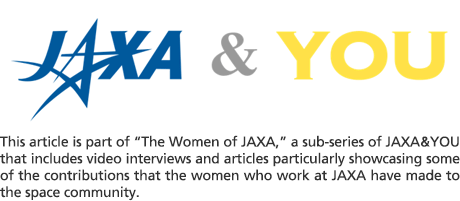
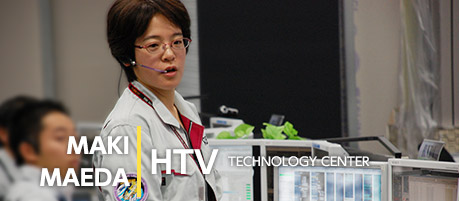
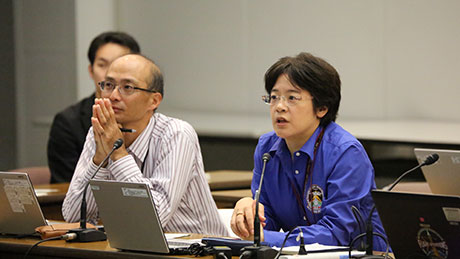
Maki Maeda (right) at a meeting with the HTV Control Room Team to discuss the launch of Kounotori HTV6.
Profile
Maki Maeda joined NASDA [now JAXA] in 1995 and began by managing work related to tracking and calculating the orbits of satellites. Since 2005, Ms. Maeda has been on the operation team for “Kounotori” (HTV), a JAXA-made transfer vehicle that delivers cargo to the ISS. In particular, she was in charge of the launch, operation, and flight of HTV1 in 2009. In 2010, she was authorized to be a Flight Director, and has acted as such since the operation of HTV2 onward. And in 2013, she was the Lead Flight Director for HTV4, overseeing the entire mission.
In this interview, Ms. Maeda discusses her work at the HTV Technology Center, the important components to a successful team, and Japan’s place in the space community.
* The interview was done in July, 2016.
Interview
Please tell us about your current job.
I am currently acting as the Flight Director for HTV (nicknamed “Kounotori”) at the HTV Technology Center. As such, I am the manager of the control room that oversees the flight of Kounotori.
What kind of role to you hold at the HTV Technology Center in the Department for Human Space Technology?
The HTV Technology Center currently has Kounotori's flights planned through the 9th iteration. At the Center, we have teams for three different large operations: The soon-to-operate-HTV6 team, the team that is making HTV7, 8 and 9, and the HTV-X team. The HTV-X team has already begun discussion including key technologies which will be applicable for future expeditions, such as going to the moon or exploring beyond that. We are also working on a micro recovery capsule that will be able to return to Earth via HTV. I personally am mainly working on the team that will operate HTV6, which will launch rather soon.*
*HTV6 launched on December 9, 2016 and completed its mission on February 6 of the following year.
You are currently serving as HTV6's Flight Director, and in aerospace one often hears that teamwork is very important. How do you encourage the ideal team environment?
Well, there are a lot of things, but one of them is that we need to identify what our final objective is and focus on that. In this case, we have to ensure that HTV delivers its payload to the ISS and reenters the atmosphere. Even when you have more immediate small objectives or little incidents, I emphasize that we are all working towards accomplishing the same objective to ensure that we all work well together. And of course, I want to make sure we all enjoy our work!
So how do you make that work fun for everyone?
Our Flight Controllers are not all in Tsukuba Space Center— we have manufacturers in Kamakura, Nagoya, Tomioka, really all over Japan. We're physically separated but working on the same technology, which can be difficult because we don't always get to talk face to face. So to find out what's going on in Tsukuba, or even on the ISS, we only talk via email. But I always write something funny so the emails are more enjoyable for the team. Then, when everyone reads my email, they think: "Whenever we get an email from Maeda she writes something funny, so I'll always read it." I think that that small jokes really help with ensuring that people are happy and having a good time.
Do you think there's anything that Japan, in particular, does well in aerospace?
The ISS could not have been built without American leadership— however, within that, literally within the ISS, there are Japanese modules and parts that no other agency has developed. For example, the robot arm and airlock that JAXA built allows things to be carried from pressurized areas within the station to ones exposed to space outside of the station, which is a unique tool for conducting experiments via the ISS. Kounotori, our vehicle for transferring supplies from the Earth to the ISS, is also unique.
The Japanese people have invented and built small but unique tools in aerospace that end up highly desired by many different countries. We still might not hold a really large leadership position, but in small areas here and there, we do very well. I think that's what's great about Japan.
So what originally got you interested in space?
The first time I really became interested in space was when Halley's comet made its approach to Earth in the 80's. At that time, it was a big event, and everyone was talking about whether they got a telescope and went to watch the comet pass. Then at school, in my science class, we had a two-week sky observation activity for homework. We took tissue paper boxes and cut one of the sides, and then pulled a wire across it, and then opened a small peeping hole in the bottom of the box. And then with that contraption, every night from the same spot on the windowsill, we peeked through the hole and observed. Through that activity, you could really see that the stars actually move ever so slightly every night. I thought that my science class was really fascinating because of that homework, and even when the assignment was over I continued to do my own observations. That experience, in addition to Halley’s comet, greatly contributed to my interest in space.
Out of your time working at JAXA, what has left the largest impression on you and why?
Since I've been here for at least 20 years, there have been lots of things— but seeing Kounotori 1 from the ISS's camera during its approach left the largest impression on me. I was continuously managing satellites, launches, and data, but before seeing Kounotori 1 from the ISS's camera, I had never before actually seen a satellite in space that I had worked on. Thus, to see HTV, the vehicle that we had flown, from another perspective— It was a moving experience.
Please give us a message to young girls interested in aerospace.
At the beginning, I had an interest in aerospace, but I didn't plan on pursuing it as a career. I thought I wouldn't be able to do something like that, that I couldn't reach that, that I wasn't someone who could go that far. But then my friends pushed me to try out aerospace, saying that I wouldn't know I couldn't do it unless I tried. Then I was accepted by NASDA [now JAXA], and now I'm doing this job. So don't decide to limit your own world. If the path is there, you should go, and if the path isn't there but you have a goal you want to achieve, then I think it's important to find your own path. I definitely want you to believe in that. There isn't anything you can't do.
I'm quite jealous of this generation, really. There's the Internet, TV, there are Japanese people active on the space station every year, it's covered by the news, those kinds of opportunities have really been increasing recently. That didn't used to be the case! In my time, all of the news on TV about space was about the launch of NASA's space shuttles. But now, Japan actually has a place in space development, and people want to work here enough that we end up on rankings of the most desired companies. So definitely don't give up! That's my feeling on the matter.
More on HTV
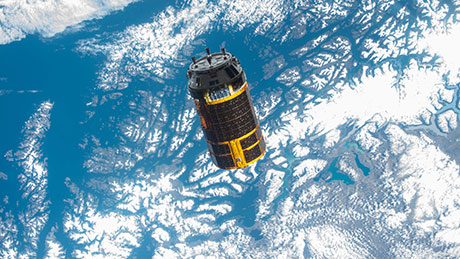
An image taken from the ISS after HTV5’s undocking in September, 2015.
The H-II Transfer Vehicle, HTV for short, is a vehicle designed and built by JAXA to transport cargo and supplies to the International Space Station (ISS). Also referred to as Kounotori [lit: stork], the HTV has successfully completed five launches and delivery of cargo since 2009. It can carry a maximum of 6,000kg per flight, and launches from JAXA’s Tanegashima Space Center. After delivering supplies, the astronauts aboard the ISS re-load HTV with waste. HTV then undocks from the ISS and falls back to Earth, burning up in reentry and disposing of the astronaut’s waste in the process. HTV has proved to be an efficient way to deliver and dispose of the ISS’s necessities and waste, respectively, which is why it continues to be employed by the ISS.
More on Asteroid Explorer
“Hayabusa 2”
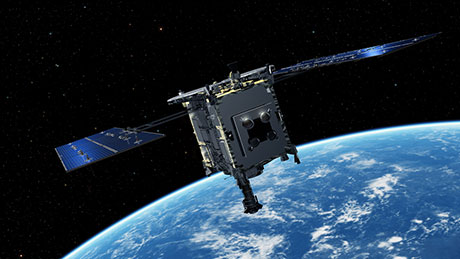
CGI of Hayabusa 2 with solar panels expanded
The successor of Hayabusa [lit: peregrine falcon], “Hayabusa 2” is an asteroid explorer that was launched in December of 2014 from Tanegashima Space Center to survey asteroid 162173 Ryugu. Once it lands on Ryugu in 2018, Hayabusa 2 will collect scientific samples for a year and a half, and then make its way back to Earth for analysis. Such expeditions are expected to give us clues to the origins of life and the universe, making them crucial for not just understanding space, but ourselves.
By Miranda Feliciano Tyson
Edited by Fumika Miyamoto
Publication date: February 17, 2017